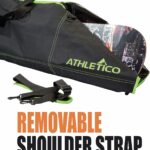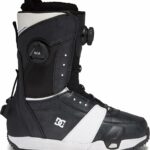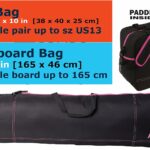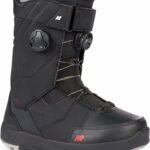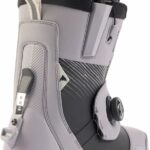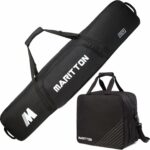Looking to hit the slopes but wondering how to determine the right snowboard binding size? This is a common enough question for both beginners and experienced snowboarders. The importance of picking the right size cannot be overstated, as it can significantly impact your performance and safety. This article will guide you through a step-by-step process, making sure your choice perfectly aligns with your boot size, riding style, and board width. So, fasten your snowboarding boots and get ready to find out everything you need to know about snowboard binding sizes!
Understanding the Importance of Correct Snowboard Binding Size
Snowboarding is a thrilling sport that requires more than just skill; it demands the correct gear to ensure safety, performance, and comfort on the slopes. An essential part of your snowboarding gear is the bindings. This is the component that connects your boots to the board, allowing you to maneuver and control your ride. Choosing the correct snowboard binding size, therefore, is of paramount importance.
The Role of Bindings in Snowboarding
As aforementioned, bindings play a central role in snowboarding. They offer direct control over the snowboard, responding to your movements and transferring those actions to the board. Bindings essentially make the snowboard an extension of your body. As a result, they significantly affect your balance, speed, and overall performance.
Consequences of Incorrect Binding Size
Mounting the wrong size of bindings to your board can not only downgrade your performance but also pose serious safety risks. If the bindings are too small, your boots could be overly constricted, cutting off circulation and causing discomfort or even pain. On the other hand, if your bindings are too large, your boots may not be adequately secured, thus leading to a loss of control and increasing the possibility of injuries.
Components of Snowboard Bindings and Their Size Variations
Understanding the different components of a snowboard binding and how their size can vary will help you make the right choice when it comes to buying or adjusting your own.
Parts of the Snowboard Bindings
A snowboard binding is typically comprised of a baseplate, straps, highbacks, and ratchets. The baseplate is the part that attaches to the snowboard, the straps secure your boots in place, the highbacks provide support for your ankles and calves and the ratchets allow you to adjust the tightness of the straps.
How Different Parts Vary In Size
Each component of the binding can come in different sizes. The baseplate needs to match your board’s width while the straps need to be long enough to securely hold your boots without creating discomfort. Highbacks, too, vary in height, and their size can influence how much support and control you have during your ride.
Measuring Your Boot Size Accurately
Just like with any other type of footwear, accurately measuring your boot size is key to ensuring the right fit.
Methods for Determining Snowboard Boot Size
Your snowboard boot size is usually the same as your regular shoe size. However, if you want to be sure, there are a couple of methods you can use. The easiest way is to measure your foot in centimeters, from heel to the tip of your longest toe. The other, known as the “Mondo” size, is the length of the inside of your boot in centimeters.
Common Errors When Measuring Boot Size
A frequent mistake when measuring boot size is not taking into account the socks you’ll be wearing. It’s recommended to wear your usual snowboarding socks when sizing. Moreover, feet can swell slightly during the day, so measuring in the afternoon or after a day of activity can give you a more accurate measurement.
Comparing Boot Size to Binding Size
Once you’ve measured your boot size accurately, the next step is to compare it to the binding size.
General Correlation Between Boot and Binding Size
Generally, the larger your boot size, the larger your binding size, and vice versa. However, it’s not always a perfect conversion due to variation in boot shape, volume and manufacturing discrepancies.
Exceptions to the Rule
Sometimes you may find that a binding labeled as your size doesn’t fit your boot perfectly. This could happen if your boots are unusually wide or slim, or if the binding is from a brand that sizes their bindings differently.
Reading Binding Size Charts
Most manufacturers provide a binding size chart to guide customers. Here’s how you read them.
Understanding Manufacturers Binding Size Guide
Typically, a size chart will tell you which binding sizes are suitable for each boot size. Remember, these are approximations and could vary slightly between brands or even models within a brand.
Translating Boot Size Units Into Binding Size
If you measured your boot size in centimeters, you might have to convert that measurement into the units used in the binding size guide, typically US mens’ shoe sizes.
Factors Influencing Suitable Binding Size
Other than the actual size of your boot, there are several other factors that can influence the suitable binding size for you.
Influence of Riding Style
Your preferred riding style could impact the binding size you need. For instance, freestyle riders might prefer a smaller, more flexible binding for improved maneuverability, whereas freeriders might want larger, stiffer bindings for more control at high speeds.
Consideration of Personal Comfort
Comfort is subjective and what feels right for one person might not for another. Thus, it’s crucial to try on different sizes and choose what feels most comfortable for you.
Level of Rider’s Experience
Beginners and less experienced riders might prefer a larger or tighter binding for more stability and control, whereas advanced riders might opt for a smaller, looser fit for flexibility and freedom of movement.
Physical Examination of Bindings Fit
You need to physically examine the binding fit on your boots before heading to the slopes.
Visual Cues of Proper Binding Fit
The binding should hold your boot securely in place without any noticeable overhang. The straps should be centered over your foot and the highbacks should align with the heel of your boot.
Feel-Test: Comfort and Restriction of Movement
Aside from the visual inspection, you should also do a feel-test. The bindings should feel comfortable and your boot should not move around inside it. At the same time, it shouldn’t restrict the natural movement of your ankle and foot.
Fine-tuning of Snowboard Bindings
Even after you’ve securely fastened your boots and bindings, some fine-tuning may be required to achieve the perfect fit.
Adjusting Binding Straps for Better Fit
If your bindings come with adjustable straps, these can be tightened or loosened to ensure a better fit. The straps should be secure but not overly tight.
Addressing Potential Fit Issues
If you notice that the binding is too loose or too tight on your boot, it’s important to address these issues immediately. This might involve adjusting your bindings or, in some cases, changing to a different binding size.
Choosing Between Different Binding Brands
Like any product, different brands offer different features when it comes to snowboard bindings. Knowing how to compare them will help you choose the best fit for your needs.
How Brand Sizing May Vary
It’s important to understand that binding sizes can vary between brands. Each company has its own size chart and the sizes may not always align perfectly. Therefore, it’s essential to consult the manufacturer’s sizing guide before purchasing.
Comparing Popular Snowboard Binding Brands
There are many popular snowboard binding brands on the market, each offering a variety of features. When comparing brands, consider factors such as the binding’s design, construction, adjustability, and of course, size. Choose the one that feels right and meets your specific snowboarding needs.
Signs Your Bindings May Be the Wrong Size
If your bindings are the wrong size, you’re likely to experience some telltale signs, particularly when you’re out on the slopes.
Physical Discomfort While Snowboarding
The most obvious sign that your bindings might be the wrong size is physical discomfort. You should not feel any pinch points, excessive pressure, or numbness when you have your boots strapped into the bindings.
Performance Issues Associated with Incorrect Binding Size
Incorrect binding sizes can also result in performance issues. You might have difficulty controlling your board, or the board might respond sluggishly or excessively to your movements. If you notice any issues with comfort or performance, it’s worth reassessing the size of your bindings.
- What Snowboard Bindings Should I Get? - January 23, 2024
- What Size Screws For Snowboard Bindings? - January 23, 2024
- How To Snowmobile On Water? - January 23, 2024

